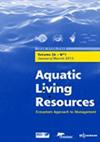Introgressive hybridization between two close species Siniperca chuatsi and Siniperca kneri (Percomorpharia: Sinipercidae) in the Middle Reaches of the Yangtze River
IF 1.9
4区 农林科学
Q3 FISHERIES
引用次数: 0
Abstract
Siniperca chuatsi and Siniperca kneri are two economically important freshwater fishes endemic to East Asia. Recently, some Siniperca specimens collected from Lake Poyang and Lake Dongting in the middle reaches of the Yangtze River couldn't be clearly identified as they showed intermediate morphological characteristics between S. chuatsi and S. kneri, and some inter-species hybrids were detected by microsatellite loci. To further verify genetic composition of these intermediate individuals, and determine the prevalence and degree of introgression between the two Siniperca species, a large set of high-quality, independent, diagnostic genetic markers were necessarily required. Based on enrichment and sequencing of target genes in sinipercid fishes, 463 loci (FST = 1) between S. chuatsi and S. kneri were selected and verified for species diagnosis. A total of 349 loci with 458 diagnostic SNPs were identified for discriminating S. chuatsi and S. kneri. From those markers, 224 diagnostic SNPs (only one SNP per locus) were selected to identify and categorize 48 specimens with intermediate morphological characters. The results showed that there were 8 specimens identified as hybrids, 8 specimens as S. chuatsi and 32 specimens as S. kneri. NEWHYBRIDS analysis showed that the hybrid offsprings were composed of the first-generation hybrid (2 individuals), first-generation backcross (1 individual), second-generation backcross (1 individual) and fourth-generation backcross (4 individuals), and the backcrossing could happen to both S. chuatsi and S. kneri. These hybrids could occur naturally, or escaped from farmed fish, due to extensive artificial breeding practice in these regions. However, the origin of the introgressive hybridization can't be easily traced. Therefore, some measures for protecting genetic resource of Siniperca speies in the Yangtze River should be enforced, such as assessing genetic background of the cultured stocks, reducing the escapement from farmed fish, and monitoring the trend of introgressive hybridization between Siniperca species in the future.
长江中游近缘种翘嘴鳜与克氏鳜的渐进杂交
翘嘴鳜(sininipera chuatsi)和克氏鳜(sininipera kneri)是东亚特有的两种重要的经济淡水鱼。近年来,在长江中游鄱阳湖和洞庭湖采集的部分鳜标本,由于形态特征介于chuatsi和S. kneri之间,无法明确鉴定,微卫星位点检测到一些种间杂交品种。为了进一步验证这些中间个体的遗传组成,确定两种鳜之间的遗传渗入率和程度,需要大量高质量、独立的诊断性遗传标记。通过对双歧鱼靶基因的富集和测序,筛选出了463个S. chuatsi和S. kneri之间的位点(FST = 1),并进行了物种诊断验证。共鉴定出349个位点和458个诊断snp,可用于区分翘氏链球菌和克奈利链球菌。从这些标记中,选择224个诊断SNP(每个位点仅1个SNP)对48个具有中间形态特征的标本进行鉴定和分类。结果表明:杂交种8份,chuatsi 8份,kneri 32份;NEWHYBRIDS分析结果表明,杂交后代由第一代杂交(2个个体)、第一代回交(1个个体)、第二代回交(1个个体)和第四代回交(4个个体)组成,而且chuatsi和kneri都可能发生回交。由于这些地区广泛的人工繁殖,这些杂交品种可能自然发生,也可能从养殖鱼类中逃逸。然而,渐渗杂交的起源却不容易追溯。因此,今后应加强对长江鳜遗传资源的保护,如对养殖种群的遗传背景进行评估、减少养殖种群的逃逸、监测鳜种间渐渗杂交的趋势等。
本文章由计算机程序翻译,如有差异,请以英文原文为准。
求助全文
约1分钟内获得全文
求助全文
来源期刊

Aquatic Living Resources
农林科学-海洋与淡水生物学
CiteScore
2.30
自引率
0.00%
发文量
10
审稿时长
>24 weeks
期刊介绍:
Aquatic Living Resources publishes original research papers, review articles and propective notes dealing with all exploited (i.e. fished or farmed) living resources in marine, brackish and freshwater environments.
Priority is given to ecosystem-based approaches to the study of fishery and aquaculture social-ecological systems, including biological, ecological, economic and social dimensions.
Research on the development of interdisciplinary methods and tools which can usefully support the design, implementation and evaluation of alternative management strategies for fisheries and/or aquaculture systems at different scales is particularly welcome by the journal. This includes the exploration of scenarios and strategies for the conservation of aquatic biodiversity and research relating to the development of integrated assessment approaches aimed at ensuring sustainable and high quality uses of aquatic living resources.
 求助内容:
求助内容: 应助结果提醒方式:
应助结果提醒方式:


